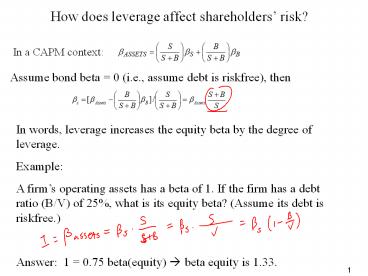How does leverage affect shareholders PowerPoint PPT Presentation
Title: How does leverage affect shareholders
1
How does leverage affect shareholders risk?
- In a CAPM context
Assume bond beta 0 (i.e., assume debt is
riskfree), then
In words, leverage increases the equity beta by
the degree of leverage.
Example A firms operating assets has a beta of
1. If the firm has a debt ratio (B/V) of 25,
what is its equity beta? (Assume its debt is
riskfree.) Answer 1 0.75 beta(equity) ? beta
equity is 1.33.
2
Review question Homemade leverage
- Refer to Example 2 in the lecture notes for
Chapter 16. On slide 17 we showed that if the
firm stayed with the original all-equity capital
structure, investors who preferred the
alternative with 50 debt financing could
effectively do this themselves by purchasing
shares and borrowing. (homemade leverage).
Suppose instead that the firm does switch to the
capital structure with 50 debt. Show that
investors who prefer the original all-equity
capital structure can effectively do this
themselves. - (i.e. to replicate the cashflows of the
unlevered firm with levered firm and
borrowing/lending. homemade unlever a firm)
3
Solution
- Step 1 Find out the payoffs of the target
- Unlevered ROE 15, B/S 0
- Step 2 Find out the payoffs of things on your
menu - levered ROE 20, B/S1, bond, r10
- Step 3 Decide your homemade leverage (or
unleverage) - The trick is that your personal portfolios
leverage leverage of target, in this case 0. - If you buy levered equity, you are buying sth.
with a leverage of 1. To reduce this leverage to
0 (the target), you need to lend out an amount
equal to (your implicit) borrowing (your firm is
borrowing but you are lending so cancel out
leverage). Solution - Buy 1 levered equity, lend 1 to bank, total
investment 2. - Return 1 (20) 1 (10) 0.3,
- Return 0.3/2 15 unlevered firm.
PowerShow.com is a leading presentation sharing website. It has millions of presentations already uploaded and available with 1,000s more being uploaded by its users every day. Whatever your area of interest, here you’ll be able to find and view presentations you’ll love and possibly download. And, best of all, it is completely free and easy to use.
You might even have a presentation you’d like to share with others. If so, just upload it to PowerShow.com. We’ll convert it to an HTML5 slideshow that includes all the media types you’ve already added: audio, video, music, pictures, animations and transition effects. Then you can share it with your target audience as well as PowerShow.com’s millions of monthly visitors. And, again, it’s all free.
About the Developers
PowerShow.com is brought to you by CrystalGraphics, the award-winning developer and market-leading publisher of rich-media enhancement products for presentations. Our product offerings include millions of PowerPoint templates, diagrams, animated 3D characters and more.

